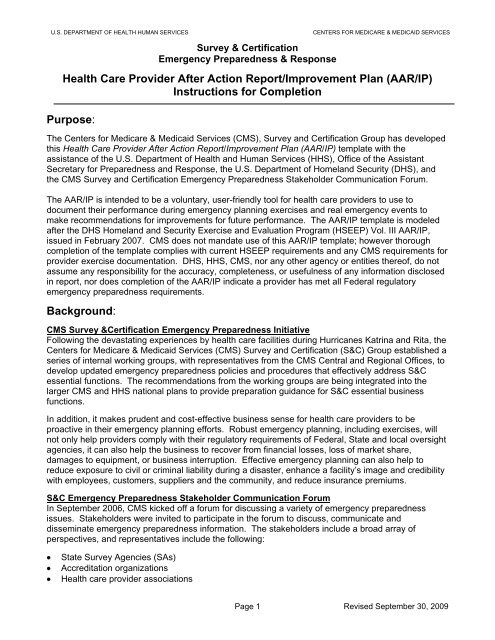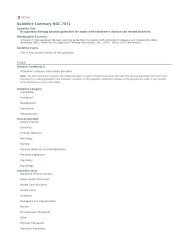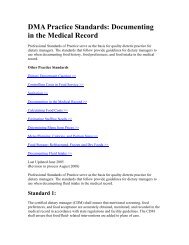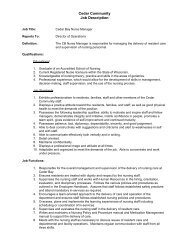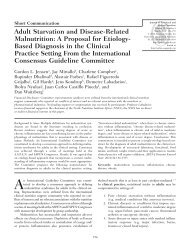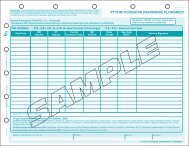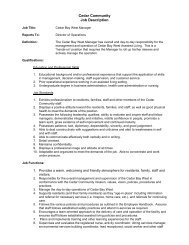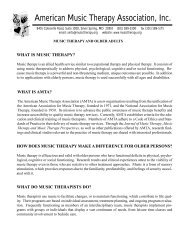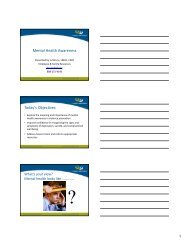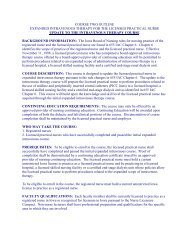Health Care Provider After Action Report/Improvement Plan (AAR/IP ...
Health Care Provider After Action Report/Improvement Plan (AAR/IP ...
Health Care Provider After Action Report/Improvement Plan (AAR/IP ...
You also want an ePaper? Increase the reach of your titles
YUMPU automatically turns print PDFs into web optimized ePapers that Google loves.
U.S. DEPARTMENT OF HEALTH HUMAN SERVICESSurvey & CertificationEmergency Preparedness & ResponseCENTERS FOR MEDICARE & MEDICAID SERVICES<strong>Health</strong> <strong>Care</strong> <strong>Provider</strong> <strong>After</strong> <strong>Action</strong> <strong>Report</strong>/<strong>Improvement</strong> <strong>Plan</strong> (<strong>AAR</strong>/<strong>IP</strong>)Instructions for CompletionActivity: Within each Capability, Activities are groupings of Tasks with similar overall purposethat usually provide an output or outcome, which is often a required input or initial starting point foranother Activity. In the <strong>AAR</strong>/<strong>IP</strong>, Activity performance will form the basis for your exerciseobservations.Task: In the EEGs, Tasks represent the expected individual actions of response personnelparticipating in the exercise. They provide the basis for evaluation, as they allow an observer theability to indicate whether an action has been fully completed, partially completed, not completed,or is not applicable to the exercise.Performance Measure: Many Tasks are followed by corresponding Performance Measures.Performance Measures consist of a prescribed action and a quantifiable indicator (usuallyexpressed as a time, percentage, or other quantity). Performance Measures should be recordedto supplement your evaluation, as they record more than the simple completion or non-completionof Tasks.Observation Key: Observation Keys are listed as sub-bullets for each Task and are intended toaid less experienced exercise evaluators to identify important indicators for execution of eachTask. They are not intended to be inclusive of all actions to be taken by responders. Rather, theyenhance the usability of EEGs as universal evaluation guides.Target Capabilities: The Target Capability List (TCL) is comprised of 37 different capabilities,which address response capabilities, immediate recovery, selected prevention and protectionmission capabilities, as well as common capabilities such as planning and communications thatsupport all missions. For these capabilities, local jurisdictions and States are the lead inconjunction with Federal and private sector support. See the following list of target capabilities(capabilities that are relevant to health care providers are displayed in red):Target Capabilities ListCommon Capabilities1. <strong>Plan</strong>ning2. Communications3. Risk Management4. Community Preparedness & Participation5. Intelligence & Information Sharing & DisseminationPrevent Mission Capabilities6. Information Gathering & Recognition of Indicators & Warnings7. Intelligence Analysis & Production8. Counter-Terror Investigation & Law Enforcement9. Chemical, Biological, Radiological, Nuclear Explosives (CBRNE) DetectionProtect Mission Capabilities10. Critical Infrastructure Protection11. Food & Agriculture Safety & Defense12. Epidemiological Investigation Surveillance & Investigation13. Laboratory TestingPage 3Revised September 30, 2009
Le numérique, un défi pédagogiqueLes technologies de l’information et de la communication connaissentune telle évolution que toute la société vit une transformation aussiimportante que celle vécue jadis grâce à l’invention de l’écriture ou del’imprimerie.Inscrire l’école dans le XXIe siècle passe donc nécessairement par ledéveloppement du numérique à l’école. Il ne s’agit pas seulement dela diffusion de technologies ni même d’équipements, mais plutôt du développement d’unestratégie globale au service des apprentissages des élèves, de la réussite de tous et sur tous lesterritoires. L’école entend être actrice, et non pas spectatrice, du numérique.Fruit d’une large concertation et présentée par le ministre Vincent Peillon le 13 décembre 2012,l’ambition numérique pour la refondation de l’école vise à placer notre pays parmi les plusdynamiques dans le développement des usages pédagogiques, des ressources, des services etdes infrastructures nécessaires. Elle entend accompagner le mouvement par la formation desenseignants. Elle vise à l’introduction de démarches plus interactives et plus collaboratives dansl’espace classe qui s’entend aussi bien dans l’espace physique de l’établissement que dans la« classe augmentée » des espaces numériques de travail qui ouvrent l’univers des possibles.Permettre aux élèves d’apprendre, de produire, d’échanger grâce au numérique dans un mondeplus ouvert, telle est l’ambition.Pour ce faire, l’ensemble des acteurs du numérique éducatif doit être mobilisé : acteurs del’Education nationale, acteurs publics, acteurs privés pour la construction de services à destinationdes élèves, des enseignants et des parents. Sont notamment concernés les différentsministères, le Commissariat général aux investissements à travers les appels e-Education, laCaisse des Dépôts autour du très haut débit, les collectivités territoriales, les éditeurs de contenuset de services numériques. Au-delà de la mobilisation des enseignants, il convient de faciliterl’essor d’une filière numérique française compétitive dans le champ de l’éducation, au traversd’une démarche collective d’innovation technologique, économique, sociale et pédagogique.La création récente de l’AFINEF (Association Française des Industriels du Numérique del’Education et de la Formation) lors du salon Educatice-Educatec en octobre 2012, sa présencesur le salon du BETT (British Educational Training and Technology) de Londres, organisé par leBESA (British Educational Suppliers Association), fin janvier 2013, révèlent un élan encourageantpour fédérer la filière et pour affirmer sa présence à l’international. La rencontre de toutes lesénergies au service des élèves, de leurs parents et de leurs enseignants, doit s’inscrire dans ladurée et dans de nouveaux modes de gouvernance : les conditions sont établies pour releverle défi du numérique à l’école et pour l’école.Jean-Paul DelahayeDirecteur général de l’Enseignement scolaireMinistère de l’Education nationale
U.S. DEPARTMENT OF HEALTH HUMAN SERVICESSurvey & CertificationEmergency Preparedness & ResponseCENTERS FOR MEDICARE & MEDICAID SERVICES<strong>Health</strong> <strong>Care</strong> <strong>Provider</strong> <strong>After</strong> <strong>Action</strong> <strong>Report</strong>/<strong>Improvement</strong> <strong>Plan</strong> (<strong>AAR</strong>/<strong>IP</strong>)Instructions for CompletionGames: A game is a simulation of operations that often involves two or more teams, usually in acompetitive environment, using rules, data, and procedure designed to depict an actual orassumed real-life situation.Operations-based Exercises validate plans, policies, agreements and procedures, clarify roles andresponsibilities, and identify resource gaps in an operational environment. Types of OperationsbasedExercises include:Drill: A drill is a coordinated, supervised activity usually employed to test a single, specificoperation or function within a single entity (e.g., a nursing home conducts an evacuation drill).Functional Exercise (FE): A functional exercise examines and/or validates the coordination,command, and control between various multi-agency coordination centers (e.g., emergencyoperation center, joint field office, etc.). A functional exercise does not involve any "boots on theground" (i.e., first responders or emergency officials responding to an incident in real time).Full-Scale Exercise (FSE): A full-scale exercise is a multi-agency, multi-jurisdictional, multidisciplineexercise involving functional (e.g., joint field office, emergency operation centers, etc.)and "boots on the ground" response (e.g., firefighters decontaminating mock victims).Note: <strong>Health</strong> care providers may also use the <strong>AAR</strong>/<strong>IP</strong> to document real life emergency events.Completing the <strong>AAR</strong>/<strong>IP</strong> Template<strong>Health</strong> care providers may customize or personalize the CMS <strong>Health</strong> <strong>Care</strong> <strong>Provider</strong> <strong>AAR</strong>/<strong>IP</strong> templateto best meet their needs; however if hospitals or other providers wish to ensure compliance with theHospital Preparedness Program and HSEEP requirements, the template sections must not bemodified and each section (except for those sections marked “optional”) must be completed in itsentirety.To personalize or customize the <strong>AAR</strong>/<strong>IP</strong> template, additional graphics, such as logos, pictures andbackground colors may be added to the cover. The document should be labeled as “Draft” on thecover page and in the header/footer of all versions except the final <strong>AAR</strong>/<strong>IP</strong>.If the <strong>AAR</strong>/<strong>IP</strong> contains graphics, figures, or tables, they should be numbered and listed in the Table ofContents section (e.g., Figure 1, Table 1, etc.).Page 5Revised September 30, 2009


